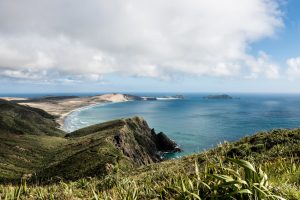
In the pouring rain, surrounded by flowing sand lava and cascading lahars, Fred Brook gingerly walks towards Matt Rayner and me. He’s sliding across a steep sand dune, his hands carefully cupped before him. Whatever he is holding appears precious. It is; Fred has hit the jackpot. Through the rain, we get a glimpse of a powerful beak, possibly thousands of years old.
Fred has found the ancient skull of a Moho, the extinct North Island Takahē (Porphyrio mantelli), that died out shortly after the arrival of Polynesians in Aotearoa. This fossilised taonga represents what we have come here to find. It is also providing a rare glimpse at what the tip of Northland could have been like then and may be like in the near future.
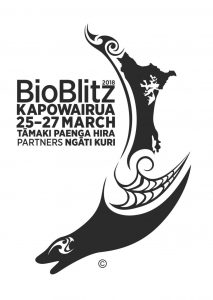
I’m standing on the otherworldly Herangi Hill at Motu i Pao/Cape Maria van Dieman, atop the giant sand dunes that cover an ancient volcano. With Fred is his son, Euan; Matt, Curator of land vertebrates at Auckland Museum; and me. Unbeknown to us, the road south on SH1 has been washed out, stranding us in this geological wonderland of the winterless north. On a dull, wet day, the exposed geology, poking through the enveloping sand, appears very muted. A few days later, under bright sunshine, the blues, greens, browns, purples and yellows, of this weathering volcano make for a geological technicolour dream coat.
The top of Northland is a far cry from where I live in Dunedin. I was lucky enough to visit the Far North as part of a Ngāti Kuri and Auckland Museum-led bioblitz. Our aim was to document the biodiversity within Ngāti Kuri’s rohe and give this ‘lost’ knowledge back to the iwi, their kaumātua and tamariki. By finding and identifying some of the ghosts of biodiversity past, we could use the fossils of birds, reptiles and marine mammals in the region to show what had been. This rediscovered whakapapa could then inform the ‘flight path’ of Ngāti Kuri’s goal of the ecological restoration of their end of Northland. I’d worked with Ngāti Kuri in the past when they named the extinct Kawau Kōhatu, the Kōhatu Shag. Being part of this bioblitz was a great way to see where some of the bird fossils came from, to give something back and, in a way, to say thank you for naming this uniquely Northland seabird.
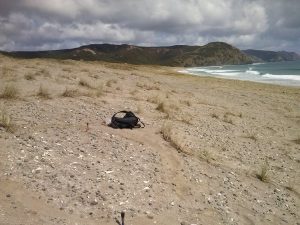
Over the week, we saw some truly stunning parts of Northland, including what has to be New Zealand’s best beach, Takapaukura/Tom Bowling Bay. After a long, hot day doing fieldwork, it was the perfect spot for a dip and a doze under an ancient Pōhutakawa, before the steep walk back up to the car. The only modern world intrusion was the New Zealand Navy reconnaissance flights over North Cape.
Working in the dunes behind Takapaukura, on a picture perfect day, just sitting on the surface of the sand, I found the tell-tale white outline I had been hoping for; a bleached femur, (i.e. thigh bone), of a prehistoric New Zealand Sea Lion, a unique lineage very different from Rāpoka/Hooker’s Sea Lion found in southern New Zealand today. By scanning the immediate area, I realised I was looking at the skeleton of a pup, it’s tiny bones poking through the sand. I can see Wilma Blom, Curator of Marine Invertebrates at Auckland Museum, on the hunt for other fossilised treasures, like the ancient jigsaw of a moa egg she had found earlier that day. Carefully excavating each bone, sieving the sand to make sure I got all the tiny fragments, I saw I had most of the pups’ skeleton. This discovery is quite special; the name Ngāti Kuri is derived from the dog [Kurī]-like bark that sea dogs, (Sea Lions and Kekeno/Fur Seals), made when their Polynesian tīpuna arrived in Aotearoa.

In a week combing Northland’s beaches, we discovered a lost world; a world markedly different from the one I’m currently experiencing. Then, forest came down nearly to the sea and covering the dunes. Sea Lions and Ihu Koropuku/Southern Elephant Seals bred on the beaches, amongst the marauding New Zealand Ravens. Moa roamed the sand hills. The flightless Moho, Kiwi, and Kākāpō walked around the understory, while the calls of Kākā and Kākāriki could be heard in the canopy. Northland was home to numerous seabirds including Kawau Kōhatu, Kuaka/Diving Petrel, Pakahā/Fluttering Shearwater and Kororā/Little Blue Penguins. Tuatara were plentiful, sharing the seabird burrows.
And those species are only what we have identified so far. The taonga we found, in collaboration with New Zealand museums, will allow us to build a picture of pre-human Northland. Sadly, some species are globally extinct, like the Sea Lion, Moa, Raven and Moho, while others are locally extinct. If they survive elsewhere in New Zealand, they could potentially be reintroduced one day to Northland.
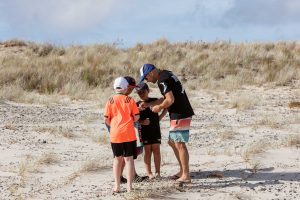
At our basecamp at Kapowairua, we kōrero with Ngāti Kuri, their kaumātua and tamariki. In our makeshift museum discovery centre, all around me, a variety of scientists including botanists, marine and freshwater biologists, entomologists, (so called bug people), and museum communicators, also back from the field, shared their discoveries with avid listeners.
Personally, I was saddened at how much knowledge of the natural whakapapa has been lost in the passage of time, so it felt good to be able to give something back; my expertise and knowledge helping Ngāti Kuri to rediscover their past. The Sea Lion, Tuatara, Kiwi and Moho are a hit. The children in our audience may be the generation that sees Northland returned somewhat to its former natural glory. Eradicating introduced predators, and that other technicolour dream coat, the invasive South American Pampas, (no, it’s not Toetoe as one tourist exclaimed), would be a good start.
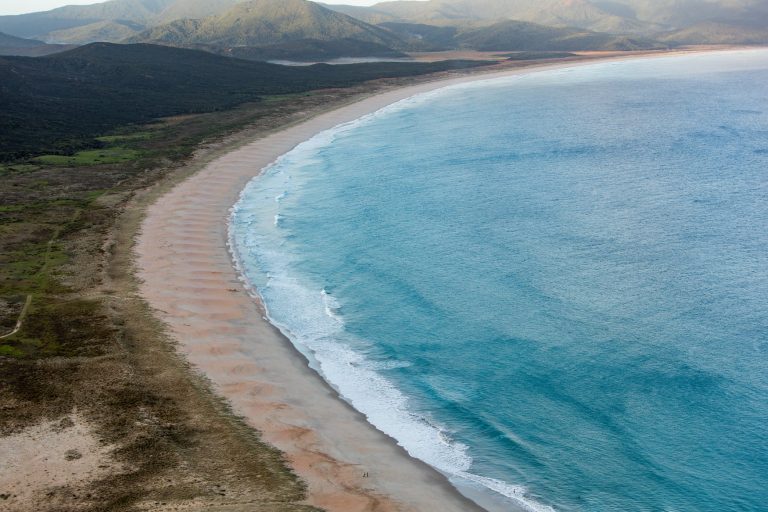
On my last evening in Northland, I sat on the beach at Kapowairua/Spirits Bay. The beach swept in a long, uninterrupted arch northwest towards Te Rerenga Wairua/Cape Reinga. The sun set over the geologically folded landscape of hill country to the west. Dark rainclouds, remnants of the storm that washed out the road south, (we still didn’t know if it was open yet), moved in front of me, creating a ghostly atmosphere, the hills drifting in and out of focus. It was as if the layers of time had been folded back, allowing me to look backwards so I could see a future. It was my little Slice of Heaven before the rat race beckoned.

Together, Fred’s Moho skull and the ghostly scene that evening are a metaphor for why we were there and what we had accomplished: ‘kia whakatōmuri te haere whakamua [I walk backwards into the future with my eyes fixed on my past]’. One day soon, Ngāti Kuri will be able to bring some of their lost taonga and ancestors home. I would love to be part of that exciting journey, Back to the Future.


Great read Nick. Let me know when you’re next passing through Christchurch, would be good to catch up!
Hi Nick! Thank you for the article. I enjoyed it a lot! I am an Environmental Scientist and I was on a hike with my husband on this exact location. My geology knowledge is not strong, however I could tell that the perfectly shaped and strong shells on the giant dunes on Cape Maria van Dieman that were visibly seen were fossils. But I could not explain how and why exactly they are there and what is the name of shell. I can send you a photo of those fossils. They were in a perfect triangle like shape. Very strong and excelently preserved. Anete